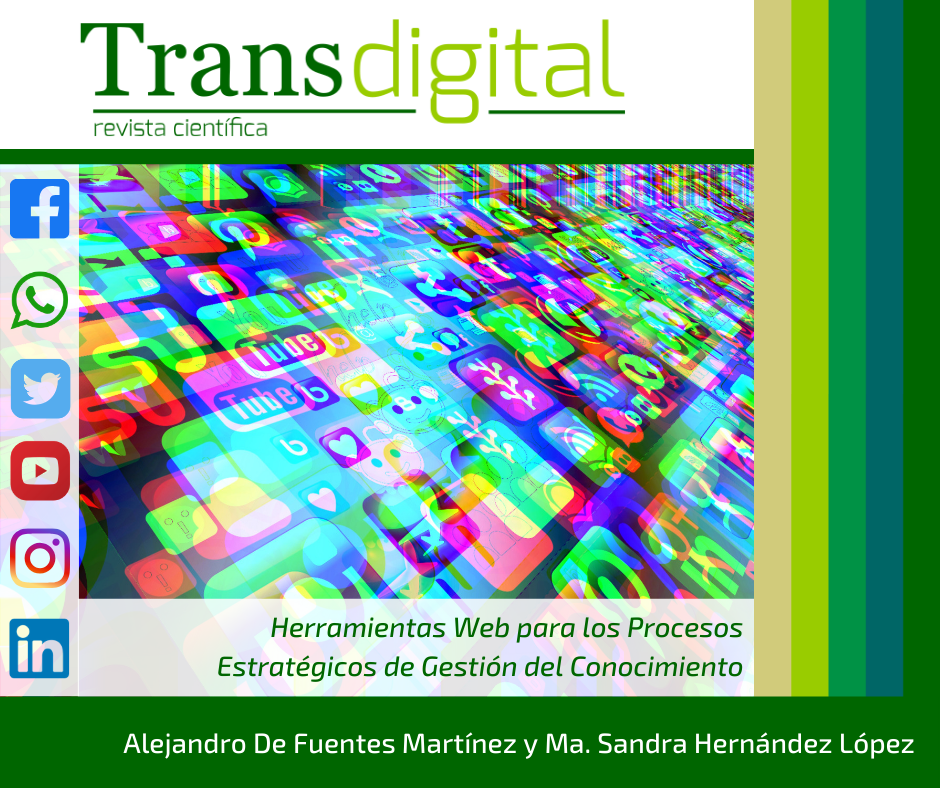Web Tools for the Strategic Knowledge Management Processes
DOI:
https://doi.org/10.56162/transdigital29Keywords:
Strategic Processes, Collective Production, Knowledge Management in the Cloud, Catalogs, Web 2.0 Tools, Cloud ComputingAbstract
The World Wide Web (WWW) emerged as a technology to support information requirements for research in high-energy physics at the Conseil Européen pour la Recherche Nucléaire (CERN). Since then its development has been permanent, going through various stages in its evolution. Through a comparative study with a benchmarking approach on various catalogs, services and available web tools, a selection of categories and tools for strategic Knowledge Management (KM) processes is presented. The results of this work reiterate a wide range of possibilities in terms of tools to carry out collective production as a strategic process of KM. The existence of a convergence between the Web 2.0 paradigm and the paradigm known as Cloud Computing (CC) is concluded in such a way that they coexist together. While one of the most relevant features of Web 2.0 is the conception of software as a service, the CC takes the technology, the services and the applications that are similar to those of the internet and turns them into a self-service utility. It is also concluded that this convergence between both paradigms supports KM processes in a ubiquitous way, that is, at any time, from any place and from any type of device.
References
Area, M., & Guarro, A. (2014). Los entornos colaborativos en la formación online. En J. I. Aguaded Gómez & J. Cabero Almenara (Eds.), Tecnologías y medios para la educación en la e-sociedad. Madrid, España: Alianza Editorial.
Berners-Lee, T., Hall, W., Hendler, J. A., O’Hara, K., Shadbolt, N., & Weitzner, D. J. (2006). A Framework for Web Science. Foundations and Trends in Web Science, 1(1), 1–130. https://doi.org/10.1561/1800000001
Castaño, C., Maiz, I., Palacio, G., & Villarroel, J. D. (2008). Prácticas Educativas en Entornos Web 2.0 (1a ed.). Madrid: Síntesis.
Ceruzzi, P.E. (2008). Historia de la informática. En BBVA (Ed.), Fronteras de conocimiento. pp. 109–127. Madrid: BBVA.
Crespo, J. L. (2015). Herramientas para la producción y difusión del conocimiento a través de la Web 2.0. Anales de la Universidad de Cuenca, 71–76. Recuperado de http://dspace.ucuenca.edu.ec/handle/123456789/23352
Custodio-López, J. J. (2012). Uso de las Herramientas 2.0 en la investigación. Revista del Cuerpo Médico, 5 (3), 49-50.
Chacín, B. (2008). Modelo teórico-metodológico para generar conocimiento desde la extensión universitaria. Laurus, 14 (26), 56-88. Recuperado de http://www.redalyc.org/articulo.oa?id=76111491004
De Benito, B. (1999): Redes y trabajo colaborativo entre profesores. Congreso EDUTEC’99. Recuperado de http://tecnologiaedu.us.es/nweb/htm/pdf/gte43.pdf.
Hoffman D.L., Novak T.P., & Venkatesh, A. (2004). “Has the Internet become indispensable? Communications of the ACM, 47(7) 37–42. https://doi.org/10.1145/1005817.1005818
León, M., Ponjuán, G., & Rodríguez, M. (2006). Procesos estratégicos de la gestión del conocimiento. Acimed. 14 (2) Recuperado de http://scielo.sld.cu/scielo.php?script=sci_arttext&pid=S1024 94352006000200008&lng=es&tlng=es
Lerma-Blasco, R.V., Murcia Andrés, J.A., & Mifsud Talón, E. (2013). Aplicaciones Web. Madrid: Mc-Graw Hill.
López M., Marulanda, C.E., & Antonio, O. (2011). Servicios de Gestión de Conocimiento Utilizando la Computación en Nube. Entre Ciencia e Ingeniería, 5 (9) 170-185. Recuperado de http://link.galegroup.com/apps/doc/A312828709/IFME?u=uvegt&sid=IFME&xid=6e887a30
Mell, P. y Grance, T. (2011). The NIST Definition of Cloud Computing. Recommendations of the National Institute of Standards and Technology. US: Department of Commerce, National Institute of Standards and Technology. https://doi.org/10.6028/NIST.SP.800-145
Merlo, J.A. (2010). Ciencia 2.0. Aplicación de la web social a la investigación. Ed. Rebiun, Madrid. Recuperado de http://eprints.rclis.org/3867/1/Ciencia20_rebiun.pdf
O’Dell, C. and Grayson, C. (1998) If Only We Knew What We Know: Identification and Transfer of Internal Best Practices. California Management Review, 40, 154-174. https://doi.org/10.2307/41165948
O'Reilly, T. (2005). What Is Web 2.0: Design Patterns and Business Models for the Next Generation of Software. Recuperado de: http://oreilly.com/web2/archive/what-is-web-20.html
O’Reilly, Tim (2007). What is Web 2.0? Design Patterns and Business Models for the Next Generation of Software, Communications & Strategies, no. 1, pp. 17-37. Recuperado de: http://papers.ssrn.com/sol3/papers.cfm?abstract_id=100883
Probst, G. Raub, S. & Romhardt, K. (2001). Administre el conocimiento. México DF: Pearson Educación.
Romero, E. (2014) Ciencias Sociales y Humanidades Digitales: una visión introductoria. En Romero Frías, E.; Sánchez González, Ma. (Coords.) Ciencias Sociales y Humanidades Digitales. Técnicas, herramientas y experiencias de e-Research e investigación en colaboración. Ed. Sociedad Latina de Comunicación Social, Tenerife. Disponible en: http://www.cuadernosartesanos.org/2014/cac61.pdf
Salinas, J. (2014). La computación en la nube y sus posibilidades para la formación. En J. I. Aguaded Gómez & J. Cabero Almenara (Eds.), Tecnologías y medios para la educación en la e-sociedad. Madrid, España: Alianza Editorial.
Sosinsky, B. (2012). ¿Qué es la nube? El futuro de los sistemas de información. Madrid: Anaya Multimedia.
Toffler, A. (1980). La Tercera Ola. Bogotá: Ediciones Nacionales Círculo de Lectores.

Downloads
Autor de correspondencia
El autor de correspodencia se identifica con el siguiente símbolo: *Published
How to Cite
License
Copyright (c) 2020 Alejandro De Fuentes Martínez, Ma. Sandra Hernández López

This work is licensed under a Creative Commons Attribution 4.0 International License.
All articles in Transdigital are licensed under a Creative Commons Attribution 4.0 International License. Authors hold the copyright and retain publishing rights without restrictions.









